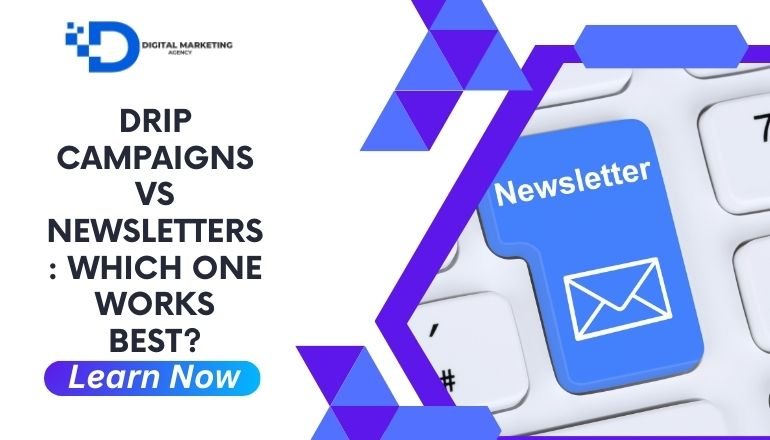In the world of digital marketing, businesses are constantly searching for effective ways to engage their audiences and boost conversions. Among the most popular methods for nurturing leads and building customer relationships are drip campaigns vs newsletters. Both strategies are designed to communicate valuable content to potential and existing customers, but they serve different purposes and require different approaches.
Whether you’re looking to educate, promote, or build trust with your audience, choosing the right strategy is crucial. At Best Digital Marketing Agency, we specialize in crafting data-driven, ROI-focused campaigns that help businesses achieve their marketing goals through tailored email strategies.
What are Drip Campaigns vs Newsletters?
Drip campaigns and newsletters are both essential tools in digital marketing, but they differ in their structure and purpose.
- Drip Campaigns are a series of automated, timed emails sent to a targeted audience based on specific actions, behaviors, or milestones (such as signing up for a free trial or making a purchase). These emails are designed to guide prospects through the customer journey, providing them with relevant content at each stage. Drip campaigns are often highly personalized and focused on lead nurturing, conversion optimization, and building long-term relationships.
- Newsletters, on the other hand, are periodic emails sent to a broader audience, usually containing company updates, industry news, or general content. They aim to keep subscribers engaged with your brand, increase brand awareness, and nurture relationships, but they don’t target users as specifically as drip campaigns.
Both play important roles in digital marketing strategies, but understanding their unique benefits and limitations can help you decide which approach works best for your business.
Why Drip Campaigns and Newsletters Matter
Both drip campaigns and newsletters are crucial in digital marketing because they allow businesses to reach their audience at different points in the buyer’s journey.
- Drip Campaigns provide a more personalized, targeted approach. By sending users the right message at the right time, businesses can increase engagement and conversion rates, guiding potential customers toward making a purchase or taking another desired action.
- Newsletters are designed to maintain consistent communication with your audience, helping to build brand loyalty and increase repeat business. While they may not be as targeted as drip campaigns, they can still provide valuable content that keeps your audience engaged and informed.
Each of these strategies plays a key role in building and maintaining relationships with your customers, making them essential for long-term success.
Key Components of Drip Campaigns and Newsletters
Drip Campaigns:
- Automation: Timed delivery of emails based on user actions or behaviors.
- Personalization: Tailored messages based on user behavior or preferences.
- Segmentation: Targeting specific groups of users for more relevant messaging.
- Conversion-driven content: Focus on leading the user toward a specific action (e.g., making a purchase).
Newsletters:
- Regular Updates: Typically sent on a weekly or monthly basis.
- Educational Content: Articles, blog posts, and industry news designed to keep your audience informed.
- Brand Awareness: Content that highlights your company’s mission, products, or services.
- Less Personalization: Often more generalized content for a broader audience.
By understanding these key components, businesses can choose which strategy aligns better with their goals and audience needs.
Best Practices for Drip Campaigns and Newsletters
When creating either drip campaigns or newsletters, there are certain best practices to follow:
For Drip Campaigns:
- Start by mapping out the customer journey and create a series of emails that guide users through different stages.
- Focus on personalization to make each message feel tailored and relevant to the recipient.
- Include clear calls to action (CTAs) to encourage users to take the next step, whether it’s making a purchase or engaging with more content.
- Use A/B testing to optimize subject lines, messaging, and design.
For Newsletters:
- Keep your content fresh, engaging, and valuable for your audience.
- Include a mix of educational articles, company news, and promotions.
- Keep it visually appealing, with a clean design and easy-to-read layouts.
- Ensure your subject lines are compelling to boost open rates and engagement.
- Both types of email marketing require continuous optimization, to improve engagement and deliver value to your audience.
Common Mistakes to Avoid in Drip Campaigns and Newsletters
While both strategies can be highly effective, common mistakes can undermine their success:
For Drip Campaigns:
- Failing to segment your audience effectively, can lead to irrelevant messages.
- Overloading subscribers with too many emails leads to unsubscribe or spam complaints.
- Not optimizing for mobile users, can cause poor user experiences.
For Newsletters:
- Sending too many newsletters without offering enough value, leads to disengagement.
- Using a generic approach with no personalization or segmentation.
- Neglecting analytics makes it hard to improve future campaigns.
Avoiding these common pitfalls will help ensure that your email marketing efforts yield the best possible results.
How Drip Campaigns and Newsletters Fit into a Comprehensive Digital Marketing Strategy
Both drip campaigns and newsletters should be part of a holistic digital marketing strategy. For example:
- Drip campaigns can be integrated with other tactics like PPC advertising and SEO to provide a seamless user experience. If someone clicks on a paid ad, a drip campaign can follow up with relevant emails to guide them toward conversion.
- Newsletters, while less targeted, can work alongside content marketing efforts to keep your audience engaged and informed about your brand.
By incorporating both strategies into your overall digital marketing plan, you can create an integrated approach that drives better user engagement, higher conversion rates, and stronger customer relationships.
Conclusion: Key Takeaways
When deciding between drip campaigns and newsletters, it’s essential to consider your business goals, the nature of your audience, and where they are in the customer journey. Drip campaigns are ideal for nurturing leads and guiding them toward specific actions, while newsletters are great for keeping your audience informed and engaged over time.
At Best Digital Marketing Agency, we can help you determine the best email strategy to fit your needs and ensure that your campaigns are aligned with your overall marketing goals. Reach out today to discover how we can help you craft a winning digital marketing strategy.













